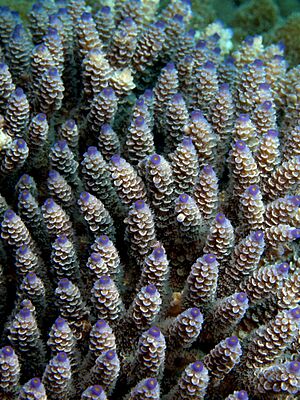Acropora secale facts for kids
Quick facts for kids Acropora secale |
|
|---|---|
 |
|
| Conservation status | |
| Scientific classification | |
| Synonyms | |
|
List
|
Acropora secale is a type of coral that looks like branching antlers. It's a "stony" coral, meaning it builds a hard skeleton. You can find it in the shallow waters of the Indo-Pacific Ocean, which is a huge area covering parts of the Indian and Pacific Oceans. The very first Acropora secale fossils found are from a long time ago, during the Pleistocene Ice Age.
What is Acropora Secale?
Acropora secale is a colonial coral. This means it lives in groups, forming low, rounded shapes. Its branches are like cylinders, but they get thinner towards the ends. These branches can grow up to 20 mm (0.8 in) wide and 70 millimetres (2.8 in) long.
How it Looks
The branches of Acropora secale grow in a special way called "corymbose." This means the lower branches are longer than the upper ones. This makes the top of the coral look flat and even.
The coral has many small cups called corallites. These are where the tiny coral animals, called polyps, live. The corallites are different sizes and are arranged in rows. Some rows have bigger corallites, and others have smaller ones.
The main corallites at the tips of the branches are about 3 millimetres (0.12 in) wide. The side corallites can be long and tube-shaped, or they can look like little noses.
The coral's hard skeleton is covered by a thin layer of living tissue. When the polyps want to eat, they stick out from their corallite cups. Each polyp has twelve tentacles around its mouth, with one tentacle being longer than the others. The mouth opens into a central stomach area. This area connects to other polyps through tiny channels inside the coral's skeleton.
Acropora secale can be many different colors. Some are purple with yellow branch tips. Others are pale brown with blue tips, or just plain green or brown.
Where it Lives
You can find Acropora secale in the warm waters of the western Indo-Pacific. This includes places like the coasts of East Africa, Mozambique, Rodrigues, Aldabra, and Chagos. It also lives further east in Singapore, Thailand, Indonesia, Japan, the Philippines, Taiwan, and parts of Australia.
This coral helps build coral reefs. It usually lives in shallow water, up to 5 metres (16 ft) deep. You can spot it on the flat tops of outer reefs, on reef slopes, and along reef edges and walls.
How it Lives and Reproduces
Acropora secale is a zooxanthellate coral. This means it has tiny plant-like organisms called dinoflagellates living inside its tissues. These tiny plants are called symbiotic because they help the coral by making food using sunlight. They also give the coral its beautiful colors, along with other pigments in the coral's own tissue.
Acropora secale is a hermaphrodite. This means each coral colony has both male and female reproductive parts. These corals release their reproductive cells (sperm and eggs) into the water at the same time. This usually happens about six days after the full moon. In the Southern Hemisphere, this is often in November. In the Northern Hemisphere, it's usually in June.
The sperm and eggs meet in the water, and this is called external fertilization. The tiny baby corals, called larvae, then float in the water as part of the plankton. They drift with the ocean currents. After some time, they settle down onto the seabed and grow into new coral colonies.


